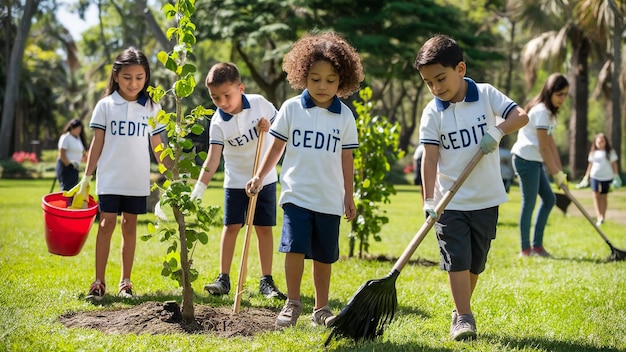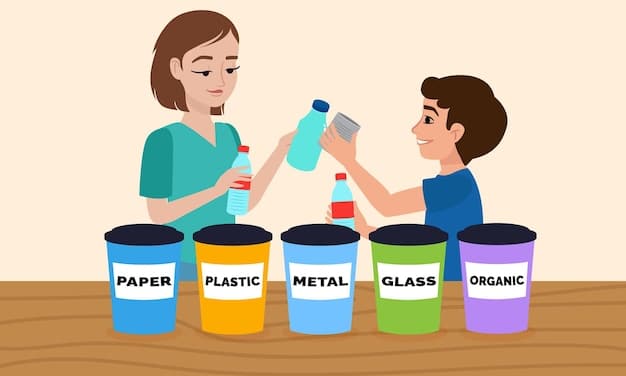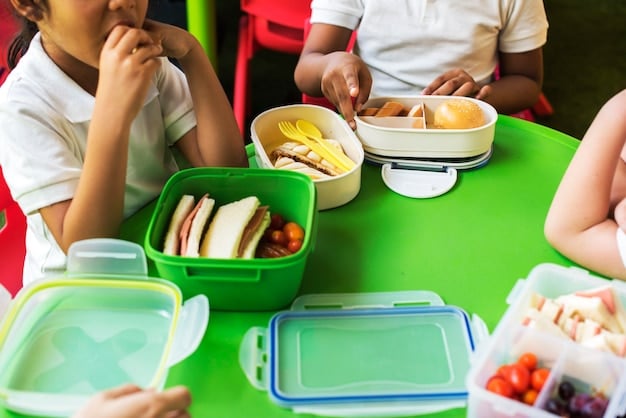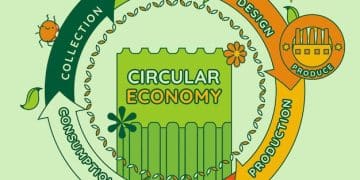How US Schools Can Cut Waste by 30% with Sustainable Practices

How can US schools implement sustainable practices to reduce waste by 30% in the next academic year? By focusing on waste reduction strategies like composting programs, enhancing recycling efforts, and integrating sustainability into the curriculum, schools can achieve this ambitious goal.
The challenge is clear: how can US schools implement sustainable practices to reduce waste by 30% in the next academic year? This isn’t just an environmental imperative, it’s an educational opportunity. By embracing innovative strategies and fostering a culture of sustainability, schools can achieve this goal and create a healthier, more responsible future.
Understanding the Urgency: Why Reduce Waste in Schools?
Reducing waste in schools isn’t merely a feel-good initiative; it’s a critical step towards environmental responsibility and resource conservation. Schools generate a significant amount of waste, contributing to landfill overflow and environmental pollution. Addressing this issue requires a multi-faceted approach focused on reducing, reusing, and recycling.
The Environmental Impact of School Waste
The sheer volume of waste produced by schools is staggering. From discarded paper and food packaging to outdated textbooks and electronic devices, schools contribute significantly to the waste stream. This waste often ends up in landfills, where it decomposes and releases harmful greenhouse gases, contributing to climate change.
Financial Benefits of Waste Reduction
Beyond the environmental advantages, reducing waste in schools can yield substantial financial benefits. By implementing effective waste reduction strategies, schools can lower their waste disposal costs, conserve resources, and even generate revenue through recycling programs. These savings can be reinvested in other areas, such as educational programs and infrastructure improvements.
- Reduced Waste Disposal Fees: Less waste means lower fees for trash collection and landfill usage.
- Cost Savings on Supplies: By promoting responsible consumption, schools can decrease their spending on paper, plastic, and other materials.
- Revenue from Recycling: Selling recyclable materials can generate income for schools, funding sustainability initiatives.

By conscientiously addressing waste reduction, schools not only protect the environment but also demonstrate fiscal responsibility. This commitment to sustainability resonates with students, parents, and the broader community, fostering a positive image for the school.
Implementing Effective Recycling Programs
Recycling is a cornerstone of waste reduction efforts in schools. However, a successful recycling program requires more than just providing recycling bins. It necessitates a comprehensive approach that includes education, infrastructure, and ongoing monitoring.
Establishing a Comprehensive Recycling Infrastructure
A well-designed recycling infrastructure is critical for maximizing the amount of waste diverted from landfills. This includes providing clearly labeled recycling bins in classrooms, cafeterias, and common areas. Additionally, schools should establish collection points for specific materials, such as electronics and batteries.
Educating Students and Staff About Recycling
Education is key to ensuring that recycling programs are effective. Students and staff need to understand what materials can be recycled, how to properly sort them, and why recycling is important. Schools can incorporate recycling education into the curriculum, organize workshops and events, and create informational materials to raise awareness.
- Curriculum Integration: Incorporate lessons about recycling and environmental sustainability into science, math, and social studies classes.
- Workshops and Events: Organize workshops, assemblies, and recycling drives to engage students and staff.
- Informational Materials: Create posters, flyers, and website content to educate the school community about recycling.

By establishing a robust recycling infrastructure and providing comprehensive education, schools can empower students and staff to become active participants in waste reduction efforts. This commitment to recycling not only reduces waste but also cultivates a sense of environmental responsibility within the school community.
Composting Initiatives: Turning Food Waste into Resource
Food waste is a significant component of the waste stream in schools. Implementing composting initiatives can transform this waste into a valuable resource, reducing landfill burden and enriching soil for school gardens.
Setting Up a School Composting Program
Establishing a composting program requires careful planning and execution. Schools need to identify a suitable composting site, select the appropriate composting method (e.g., vermicomposting, backyard composting), and secure the necessary equipment. Additionally, it’s essential to develop a collection system for food scraps from the cafeteria and other areas.
Educating Students and Staff About Composting
Similar to recycling, education is crucial for the success of composting programs. Students and staff need to understand what types of food scraps can be composted, how to properly collect and sort them, and the benefits of composting. Schools can incorporate composting education into the curriculum, organize workshops, and create instructional materials.
- Curriculum Integration: Integrate lessons about composting and soil science into science and environmental studies classes.
- Workshops and Demonstrations: Host workshops and demonstrations to teach students and staff about composting techniques.
- Instructional Materials: Create posters, guides, and videos to educate the school community about composting best practices.
By implementing effective composting initiatives and providing comprehensive education, schools can significantly reduce food waste, create a valuable resource for school gardens, and promote environmental stewardship. This holistic approach not only benefits the environment but also enhances the educational experience for students.
Reducing Paper Consumption with Digital Tools
Paper consumption is a major contributor to waste in schools. Adopting digital tools and promoting paperless practices can significantly reduce the amount of paper used, conserving resources and reducing environmental impact.
Implementing Digital Learning Platforms
Digital learning platforms offer a wealth of resources and tools that can replace traditional paper-based materials. Schools can transition to online textbooks, assignments, and assessments, reducing the need for printed materials. These platforms also offer interactive features that enhance student engagement and learning outcomes.
Promoting Paperless Communication
Schools can also reduce paper consumption by promoting paperless communication among staff, students, and parents. This includes using email for announcements, newsletters, and other communications, as well as utilizing online portals for submitting forms and accessing information. By embracing digital communication, schools can significantly reduce their reliance on paper.
Effective strategies include encouraging teachers to submit assignments and feedback online. Not only **how can US schools implement sustainable practices to reduce waste by 30% in the next academic year**, but how can they create a more efficient operation.
- Email Communication: Use email for announcements, newsletters, and internal communications.
- Online Forms: Utilize online forms for student registration, permission slips, and surveys.
- Digital Portals: Provide access to student records, assignments, and resources through online portals.
By implementing digital tools and promoting paperless practices, schools can dramatically reduce paper consumption, save money, and promote environmental responsibility. This transition not only benefits the environment but also prepares students for a digital future.
Engaging the Community in Sustainability Efforts
Sustaining a long-term commitment to sustainability requires the active involvement of the entire school community, including students, staff, parents, and local partners. By fostering a culture of collaboration and shared responsibility, schools can create a more sustainable future.
Creating a Green Team
A Green Team is a group of students, teachers, and staff dedicated to promoting sustainability initiatives within the school. The team can lead awareness campaigns, organize events, and implement waste reduction programs. By empowering students to take ownership of sustainability efforts, schools can cultivate a sense of environmental stewardship.
Partnering with Local Organizations
Collaborating with local environmental organizations can provide schools with valuable resources and expertise. These organizations can offer workshops, training programs, and technical assistance to support sustainability initiatives. Additionally, partnerships can connect schools with community resources, such as composting facilities and recycling centers.
These joint ventures will show **how can US schools implement sustainable practices to reduce waste by 30% in the next academic year**. The school’s waste will decrease as external support increases.
- Workshops and Training: Partner with organizations to offer workshops and training programs on sustainability topics.
- Technical Assistance: Seek guidance from experts on implementing waste reduction strategies.
- Community Resources: Connect with local composting facilities and recycling centers to manage waste effectively.
By engaging the community in sustainability efforts, schools can create a powerful network of support and collaboration. This collective approach not only enhances the effectiveness of waste reduction programs but also fosters a shared commitment to environmental responsibility.
| Key Highlight | Brief Description |
|---|---|
| ♻️ Recycling Programs | Comprehensive recycling infrastructure & education for proper sorting. |
| 🍎 Composting | Transforming food waste into resource for gardens. |
| 💻 Digital Tools | Reducing paper use in schools through digital learning platforms. |
| 🤝 Community Engagement | Involving students, staff, and parents in sustainability initiatives. |
Frequently Asked Questions (FAQ)
Start with a waste audit to understand where waste is coming from. Then focus on quick wins like improving recycling and reducing single-use plastics.
Make recycling easy and convenient by placing clearly labeled bins everywhere. Reinforce good habits with educational programs and fun activities.
Challenges include funding, lack of awareness, and resistance to change. However, with a focus and collaboration this can be achieved.
Most schools can implement composting programs, even those in urban settings. Options include vermicomposting, and partnerships with local farms.
Community buy-in fosters a shared commitment. Engaged parents, students, and local organizations amplify the impact of waste reduction initiatives.
Conclusion
Reducing waste in US schools is more than an environmental goal – it’s an investment in a sustainable future. By implementing the strategies outlined, including recycling, composting, and digital tools, schools can significantly reduce waste and create a culture of environmental stewardship. How can US schools implement sustainable practices to reduce waste by 30% in the next academic year? By taking decisive action.





